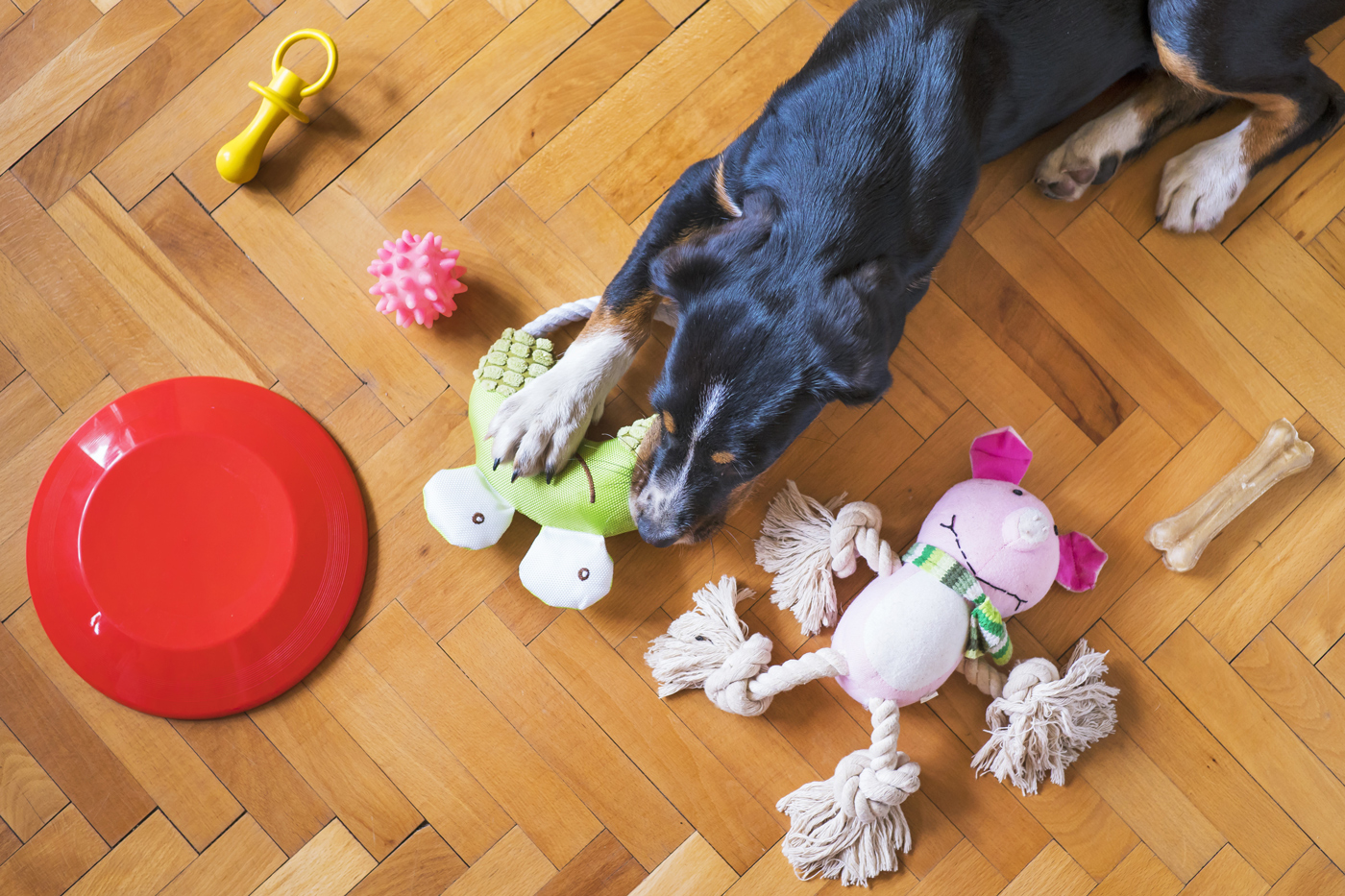5 intelligence tests for dogs
22nd June, 2021

Who’s a clever boy then? It’s a question that many owners ask their dogs – and get nothing more than a wagging tail as a reply.
So how can you discover if your clever boy or girl really is a canine Einstein? What tests can your dog take to demonstrate its own IQ? Can your dog learn new tricks, or is it happier chasing its own tail?
We’ve put together five tests to help you detect whether your pooch’s furry exterior hides a surprisingly sharp brain. Read on to find out more.
And remember: smart or not-so-smart, your pup deserves the very best care from you. Insurance for your pet can help cover the costs of vets’ fees, helping to keep your pooch at the top of its game for years to come.
Carrying out dog intelligence tests
It goes without saying that dogs show their intelligence in different ways from humans. Even the cleverest is not going to fare well in a reading comprehension exam - but will beat you paws down in a sniff test!
And one breed differs from the next. A sight hound such as a whippet will ace any vision test, but – perhaps surprisingly – perform poorly when it comes to smells.
A bloodhound can sniff out pretty much anything anywhere, but those floppy ears prevent it from hearing well.
So our five simple tests below aim to give you insights into your dog’s intelligence by assessing not their senses, but underlying qualities like quickness to learn and ability to solve problems.
But remember: this should be nothing more than a bit of fun. The last thing you want to do is stress out your dog – it will become miserable, and won’t perform well.
So choose a time when you and your canine are happy and relaxed. Treat these tests as fun games to play together, rather than major exams!
If your dog seems anxious at any point, stop the game and give it a good stroke and plenty of verbal reassurance.
If it whines and backs away, it’s letting you know it has had enough. In fact, the ability to communicate well with humans is one clear indicator of dog intelligence, so you’ve already got your answer!
And above all, use treats to motivate your dog to take the test, reward it for success, and console it for failure. Even the cleverest canine is quite a simple creature, and the way to its brain is through its stomach!

Problem solving
You probably already have a good idea if your pooch is capable of solving problems.
Maybe you thought you put that freshly baked cake out of reach before leaving for work, but return to discover nothing more than crumbs on the floor and a guilty look on Fido’s face. How on earth did he clamber up your kitchen cabinets?
Or perhaps you tried to turn your garden into Fort Knox, but have quickly discovered that your Houdini-like hound has somehow managed to unlock the gate and make a run for it.
That’s just one of the many reasons why pet insurance that covers straying mutts can come in handy!
However, if you’re still unsure, there are a few problem-solving tests you can try.
The simplest is to buy a puzzle feeder – there are several types on the market, and some will be better suited to your dog than others.
Simply place a tasty treat inside, and see how quickly your dog works out how to get to that tempting scent. Your dog will probably enjoy the challenge – all mutts love a bit of mental stimulation to keep their brains active.
Alternatively, you could set up your own puzzle. Try using chairs to create a gap that’s too narrow for your dog to squeeze through, then drop a treat on the other side.
How quickly will it work out that to get the treat, it needs to go the long way around the chairs, rather than simply try to squash its body through an impossible space?
Hopefully, your pup will make its own way to its reward. If not, don’t torture it for too long – give it a treat for trying. Even dim-witted dogs deserve tasty titbits!
Object permanence
It can seem a bit much to expect your dog to understand ‘object permanence’ when the longest word in its vocabulary is ‘walkies’. After all, you might not be entirely sure what it is yourself!
But really, it’s just a grand phrase for a concept that’s very simple – to humans, at least. It’s the idea that an item still exists even if you can’t see it. So sadly, that dust is still there, even though you’ve swept it under the rug.
To check if your dog grasps this basic law of physics, show it a treat. It’s best to choose one without a strong scent, otherwise that gives the game away. If your dog is a breed that has a particularly acute sense of smell, try this test with a toy instead.
Now hide it under a cup. Does your dog try to overturn the cup to get at the treat? Or does it just assume that the treat has disappeared into thin air, and slink off sadly to its basket to dream of tasty morsels?
If it’s the former, congratulations to your clever canine! Either way, it’s time to give your mutt its reward for being a good sport.

Memory test
If your dog aces the cup test above, then why not see how it fares in a memory test?
You’ll need one treat and three cups for this. Again, let the dog see which cup you’re placing the treat under, but don’t let it knock the cup over and guzzle the snack straight away. Instead, lead it out of the room – bribe it with a treat if necessary.
After a short while, let your dog back into the room. Does it remember that there’s a reward lurking under one of the cups? And, even better, can it remember which one?
Of course, just as with humans, it’s highly beneficial for a dog to have a good memory. It means that if it gets lost, it’s more likely to be able to sniff its way back home.
That said, sharp-brained dogs might get themselves into more scrapes as they seek fresher, more exciting forms of mental stimulation: new scents to sniff, new dogs to play with. Either way, pet insurance can help reunite you with a straying dog, or cover vets’ fees if your pooch gets into a pickle.
Time it
Even pretty slow-witted pups may learn the above tricks, given enough time. So one way to test your canine’s cognitive capacity is by timing how quickly it understands something it’s never encountered before.
One trick you could try is to throw a cloth over its head and see how quickly it frees itself (choose a light cloth, and let the dog smell it first so it’s not alarmed).
Or how about tying a treat to a piece of string, pulling it under a sofa, and leaving the string within the dog’s reach? How quickly will it work out that pulling on the string gets the treat out more quickly than trying to muzzle it out?
If it’s a matter of seconds rather than minutes, you’ve got a canny canine!
Confuse your dog!
As mentioned above, dogs tend to stick to what they know. So to find out how quick your pooch is to learn, you need to shake things up a bit.
Perhaps it has a favourite spot in your living room? When it’s out of the room, rearrange the furniture. Let it back in, and see whether it goes straight to its old favourite spot, or whether it just looks bemused.
Or maybe you always eat breakfast, then reach for your dog’s lead to take it for a walk. Try picking up the lead at an unusual time of day, and see if your pup reacts with excitement or bewilderment.
Of course, as with many of the above tests, there’s more than one way to interpret the findings. Maybe the reason it takes time to find its favoured spot is because it wants to explore the new living room layout. Perhaps it was barking at something completely different.
Really, you know your dog best. And you probably don’t really mind whether it’s intelligent or not: either way, it’s your perfect pet.

The importance of exercising your dog’s brain
Whether you’ve got a clever collie or a dopey dachshund, it’s important that you keep it mentally stimulated. There are several reasons why you should keep teaching your young or old dog new tricks throughout its life.
Firstly, a bored dog is a destructive dog. If your sharp-witted sheepdog has the same tired old toys to play with each and every day, it will soon turn its attention to something else. It might try to escape the confines of your home, or chew up your belongings. Either way, it’s bad news.
Secondly, dogs that use their brains are happier. Many belong to breeds that were bred to work: for example, collies as shepherd dogs, and Cocker spaniels as gun dogs.
They enjoy the feeling of fulfilment and accomplishment that comes with training. If they get praise from you for learning something new, even better!
And finally, older animals need to keep their brains active in later life to avoid canine cognitive dysfunction, or dog dementia. While there’s no cure for this, mental stimulation can slow the decline, and help dogs relearn any skills they forget.
If you’ve noticed your old dog seems to have forgotten some of its training, or shows any other signs of cognitive decline, talk to an expert. With insurance for pet's from Purely Pets, you get access to a 24-Hour Vet Helpline for all your worries and queries.
Which breeds are the canine clever clogs?
If you want a bright spark of a dog, then there are certain breeds you should choose – and a few you should avoid.
Top of the list has got to be the border collie, widely regarded as the most intelligent of all domestic dog breeds.
They’re bred for farm life, working in partnership with their human masters to design and implement the perfect shepherding plan. Admittedly, they’re only pitting their wits against sheep!
Other working breeds are also pretty clued up – at least in their own area of expertise. Golden retrievers, Jack Russell terriers and even poodles are sharp-witted animals, as well as lovely family dogs.
And what about the least intelligent? Generally, this means those that are hardest to train – which might be because they’re stubborn or easily distracted rather than stupid. But Afghan hounds, beagles and bulldogs are not widely known for their smarts.
However, that doesn’t mean you shouldn’t choose one as your own four-legged friend. Beagles in particular are a highly sought-after family pet thanks to their affectionate and playful nature.
Whichever animal you choose, it deserves the very best care. Pet insurance from Purely Pets will help cover the cost of vets’ fees, so your pet brings joy to you and your family for years to come. Intelligence isn’t everything!
At Purely Pets, we love all dogs, no matter how smart or goofy. That’s why we’ve put together 15 cover levels of award-winning lifetime pet insurance to help protect the four-legged members of your family.
Cover benefits include vets’ fees up to £15,000 and excess starting at just £60, both depending on the policy level you choose.
If your dog is lost through theft or straying, your insurance will help cover the costs of reuniting you with your pet. Other policy benefits include cover for special diets, complementary treatments, and third party liability.
Plus, Purely Pets offers you a vet advice line for all your concerns and queries, and we make it easy for you to manage your policy online.
Get a quick quote for pet insurance today.
Policy benefits, features and discounts offered may very between insurance schemes or cover selected and are subject to underwriting criteria. Information contained within this article is accurate at the time of publishing but may be subject to change.
Helpful Pages
Recent Posts
Pet Insurance Quote
- 98% claims paid *
- Claims paid directly to vets
- 24/7 vet video consultations
- Interest free monthly payments




